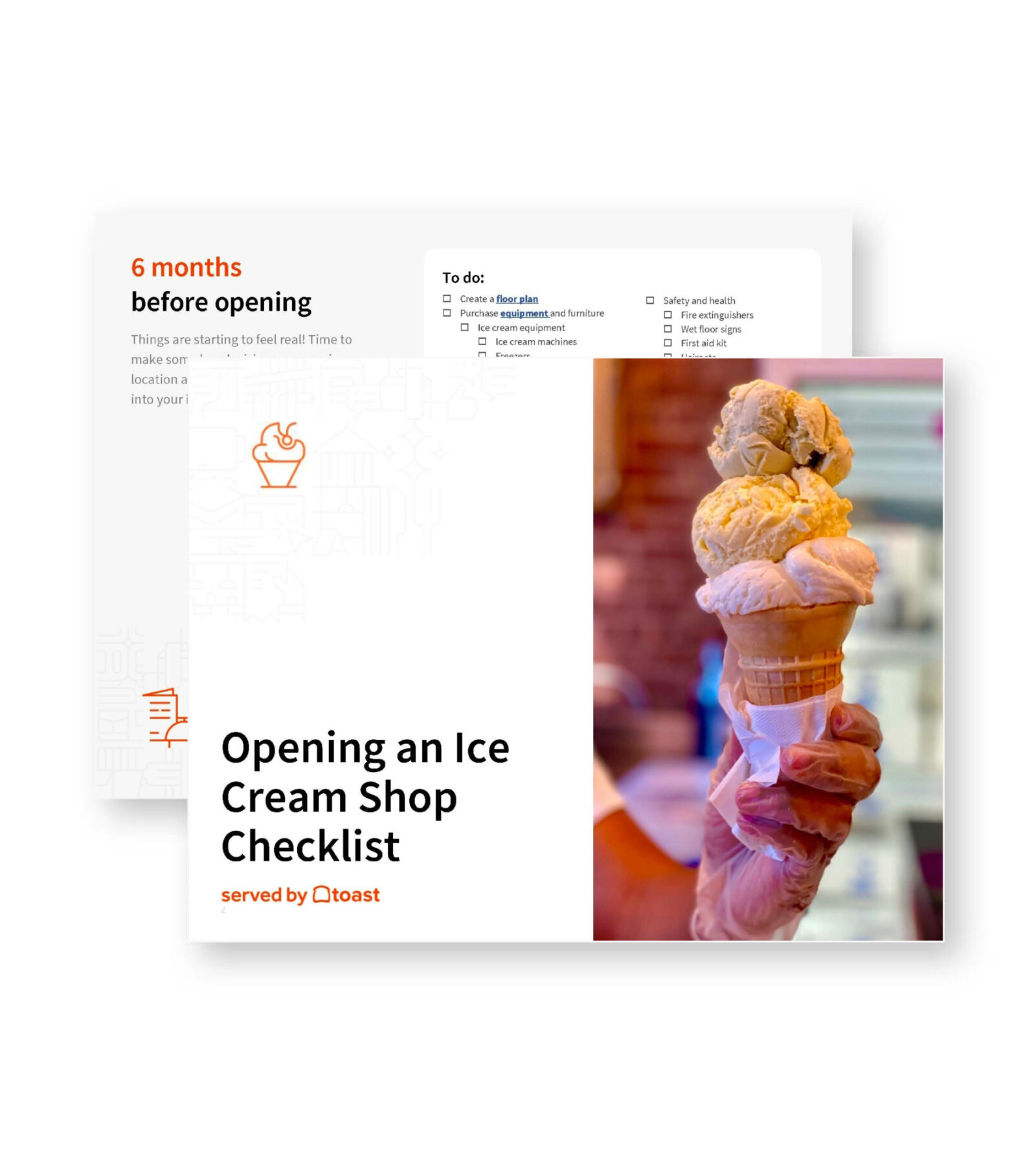
How to Open an Ice Cream Shop: Starting an Ice Cream Business Steps
Do you dream of making and serving ice cream to happy customers? Read on to learn how to open an ice cream shop.

Katherine BoyarskyAuthor


Opening an Ice Cream Shop Checklist
So many things go into opening an ice cream shop. With this free PDF checklist, you'll set your new business up for success.
Get free downloadWhat Do You Need to Start an Ice Cream Shop Business? (Checklist)
2020 and 2021 have been challenging years for the food and restaurant industry, but ones that also presented opportunities for restaurants and food businesses to pivot and get creative, many adding new delivery options or working from ghost kitchens. One subcategory of the industry had a banner year: dollar sales for ice cream businesses were up 13.4% to over $6.8 billion overall sales in 2020, based on a report out of Chicago.
This might mean you're considering taking the plunge and opening an ice cream shop of your own. Grab your favorite pints for inspiration, and keep reading.
To make sure you set up your ice cream shop for success, here are the steps for how to open an ice cream shop and create the ice cream shop of your dreams.
1. Choose an Ice Cream Shop Format
One of the very first decisions you need to make about your ice cream shop is the format. While it may not seem like it at first, the format will dictate the design and atmosphere of your shop.
The ice cream shop formats to choose from include:
Dine-in: Dine-in spaces create areas for gathering and socialization, and allow for the inclusion of tables and seating for customers. Either outdoor or indoor, ice cream shops can use counter-only service or servers.
Counter only: Counter only ice cream shops don’t offer any seating to customers and instead consist entirely of a counter for ordering and picking up treats. This is the most common setup for ice cream shops.
Window only: Window only ice cream shops are exactly what they sound like — stores that operate entirely out of a window or series of windows.
Ice cream truck: A popular choice, particularly in larger cities, ice cream trucks allow businesses to meet their customers where they already are.
2. Write your Ice Cream Shop’s Business Plan
Without taking the time to develop a business plan, you run the risk of missing important steps along the way that are hard to retroactively complete. Use this time to develop an understanding for the present and future of your shop and start to think about your ideal customers, marketing plan, and restaurant business operations.
Your ice cream shop business plan should include:
An outline of all projected growth over the first five years.
A market analysis that includes your local competitors and how your shop will fit in the industry at large.
An executive summary detailing the purpose of your ice cream shop and your plans for the success of your shop.
An outline of your marketing strategy.
An outline of your sales strategy.
And of course, the name of your ice cream shop. (It’s always a good idea to search the U.S. Patent and Trademark Office to see if your name has already been taken.)
To get started writing yours today, check out our Restaurant Business Plan Template.
Restaurant Business Plan Template
No matter where you’re at in your restaurant ownership journey, a business plan will be your north star. Organize your vision and ensure that nothing is overlooked with this free template.

3. Find the Right Location for your Ice Cream Shop
Depending on your target audience, the location of your ice cream shop could dictate your success. First things first, decide if you’ll be looking for your shop on your own or with help from a commercial real estate agent. Next, examine foot traffic patterns, surrounding businesses and restaurants, and available leases from former restaurants (or more specifically, sweet shops or ice cream places).
4. Obtain the Necessary Restaurant License and Permits
It’s always a good idea to start local when collecting the restaurant permits and licenses you need to open your ice cream shop. Most states and even counties have their own regulations regarding new businesses, to be sure you don’t miss any deadlines you’ll want to start collecting them early.
The licenses and permits needed to open an ice cream shop include, but are not limited to:
Health and safety inspection
Sales license
Zoning permits
Food handler’s license
Catering license
After you’ve determined all the paperwork you need, start filling it out right away. Some permits may be contingent on others, and without starting early you may risk a delay in the grand opening. Work with a professional to ensure you've done this step perfectly to avoid headaches.
5. Collect the Necessary Tax, DBA, and EIN Information Needed to Open your Ice Cream Shop
Many states have differing employer and tax requirements, in addition to potentially requiring different licenses and permits. In a similar fashion, it’s also best practice to start this process as early as you can to avoid missing deadlines.
Start by collecting the necessary restaurant tax paperwork through either a third-party or an in-house tax professional. Then, if necessary, file for your DBA — AKA your ice cream shop’s trade name. Last, if hiring employees is part of your plan at any point, you’ll need to apply for an EIN (employer identification number) that will allow you to file income and payroll tax returns. Again, this is a step where professional help is extremely important.
Setting Up your Business Structure
For setting up your restaurant’s taxes, you’ll need to establish your shop and choose a business structure. An LLC can protect you from personal liability, and other business formats are beneficial for other reasons, like if you sell merchandise or have several locations. Do your research and consult with a professional on this step if you have any concerns.
6. Design your Ice Cream Shop Branding, Marketing, Promotion, and Advertising Strategy
Developing the marketing and advertising strategy for your ice cream shop starts with you creating a clear vision of what it is exactly that you're marketing. What makes your ice cream shop special? Why should customers go to your shop instead of the ice cream shop down the street? Questions like these will drive your unique branding. Then, once you’ve defined what your parlor has to offer, proceed with designing the right marketing strategy for your operation.
Ask yourself guiding questions while developing your branding, and always keep the ideal customer in mind:
Will you pay for advertising or use organic marketing practices?
Where does your target audience spend their time? Are you able to advertise in these spaces?
What platforms will you use for marketing? What about advertising?
Will influencer marketing play a role in your strategy? To what degree?
What is your social media marketing strategy?
Toast’s Restaurant Marketing Plan template can help serve as a starting point to get your marketing strategies in a row, set up your marketing channels like email, social media, and your website, and plan for the year.
Restaurant Marketing Plan
Create a marketing plan that'll drive repeat business with this customizable marketing playbook template and interactive calendar.

7. Determine your Ice Cream Shop Finances, Sales Forecasts, and Operating Expenses
Opening an ice cream shop can be a great source of revenue and has excellent profit margins. The average ice cream shop makes $100,000-$600,000 every year. Here’s how to plan for your restaurant operating expenses and a simple way to project future revenue.
Restaurant Finances + Operating Expenses
Restaurant expenses include food supplies and other equipment and materials, ongoing operations like utilities, software, packaging, and marketing, and labor costs. Prepare for unexpected restaurant startup costs like repairs or supply chain shortages and include incidentals in your restaurant budget.
Operating expenses for ice cream shops can include utilities, equipment, appliances, licenses, permits, technology, and food costs. These vary based on renting or buying equipment, the cost of rent or supplies in a given region, square footage, and more.
It’s best practice to create a second bank account to differentiate between your personal and business expenses. In some states, opening a separate business account is mandatory. Additionally, this is a good time to get a business credit card and start building business credit. Work with an accountant you trust to help you with this.
Restaurant Sales Forecasting
To create a basic projection for your ice cream shop sales, take your projected revenue and deduct expenses. Use a monthly estimate to project your growth. Once you’re established as a business, you can use month over month growth rate to project future years of revenue.
8. Gather all of your Funding and Loans
For a new ice cream shop, there are a variety of paths you can take to gain funding. Along with standard business loans, there are many government grants that you can apply for, including:
Startup business grants
A business line of credit
Equipment financing for the ice cream kitchen or prep area
SBA Microloans for small-businesses
To learn more, read about all the different ways you can get restaurant financing.
9. Create Your Ice Cream Shop Menu
Ice cream shops are an example of a restaurant with a seemingly very straightforward menu. Isn’t it just ice cream? However, as always when it comes to the food industry, personality and atmosphere go a long way. Regardless of whether or not your menu diverts from the traditional ice cream shop offerings, you can still make your menu memorable by infusing it with your shop's unique brand.
Customers flock to new, unique offerings and will be looking for what sets your shop apart from the rest. Craft a menu that is inviting and fresh and employ a strategic menu design that drives new business to your shop.
Tip: Consider offering an online ordering menu for ice cream treats like ice cream sandwiches, pre-packaged quarts or pints of your homemade ice cream, or seasonal flavors and sundaes.
10. Purchase and Track Your Restaurant Inventory
Once you’ve crafted your menu and you know exactly what products, ingredients, and equipment you’ll need to make it a reality, it’s time to begin ordering your inventory. First step — decide where you will be buying your supplies from.
With so many food wholesale platforms to choose from, it’s important to take your time to read through supplier reviews and to talk with your peers about where they obtain their supplies from. Avoid falling into the trap of working with a supplier with poor communication skills or consistent shipping delays. Instead, shop around until you find a supplier that you trust. Additionally, it’s always a good idea to check out local suppliers for small-batch and specialty ingredients.
Next, set up a restaurant inventory management system that can track food costs and sales, giving you insights on profitable items and areas for menu design improvements.
Remember, your relationship with your supplier is ongoing. Continuously track your shipments and create a contingency plan for yourself should a delay occur.
11. Buy an Ice Cream Shop Point of Sale System
No ice cream shop is complete without a high-functioning point of sale system. The best POS systems are intuitive and easy for employees to learn how to navigate — two coveted qualities for emerging restaurant businesses.
Toast’s Cafe and Bakery POS system, which ideal for small food businesses like ice cream shops too, does all that and more. It provides you with the equipment you need to quickly train new hires and optimize your payment process.
Features of restaurant POS systems that help new shops grow include:
Handheld/portable: For pop-up shops or food trucks, a handheld POS lets you accept payment right from the device (like Toast Go™).
Intuitive POS menu: Having a simple interface and large buttons improves the user and customer experience.
Kitchen display: Clear communication between the kitchen and the front of house can reduce customer wait times and speed up orders.
For more information, here’s everything you need to know about Toast’s Restaurant POS System.
12. Craft the Design and Atmosphere of your Ice Cream Shop
What is your personal story and how can you manifest your experiences as design elements in your ice cream shop? Restaurants with the most inviting atmosphere have nailed down their restaurant design and used strategy to create a space to serve their ideal customers and provide the right environment to fit their needs.
Ultimately, the goal is to create an ice cream shop that is both an accurate reflection of your values and a place where customers want to spend their time and money.
Restaurant design elements to consider for your ice cream store include:
Seating
Window service
Display windows
Kitchen space
Will your ice cream shop be reminiscent of a soda shop of the 50s, or a hybrid ice cream shop cafe where customers can enjoy an affogato after a late meal?
13. Hire your Ice Cream Shop Team and Management
Lastly, it’s time to hire the dream team that you are going to task with running your ice cream shop each and every day. Depending on the format, design, size, and location of your shop, you may find yourself hiring:
Shift leaders
Chefs
Baristas
Cashiers
Managers
Seek out new restaurant hires on restaurant industry job sites like Culinary Agents or reach out to contacts in the food service space.
Start Churning!
Now all that’s left to do is prepare for the opening day! To round out your plans for opening a new ice cream parlor, complete your business plan using the Restaurant Business Plan template.
Related Ice Cream Resources
Restaurant Business Plan Template
No matter where you’re at in your restaurant ownership journey, a business plan will be your north star. Organize your vision and ensure that nothing is overlooked with this free template.

Is this article helpful?
DISCLAIMER: This information is provided for general informational purposes only, and publication does not constitute an endorsement. Toast does not warrant the accuracy or completeness of any information, text, graphics, links, or other items contained within this content. Toast does not guarantee you will achieve any specific results if you follow any advice herein. It may be advisable for you to consult with a professional such as a lawyer, accountant, or business advisor for advice specific to your situation.
Read More
Subscribe to On the Line
Sign up to get industry intel, advice, tools, and honest takes from real people tackling their restaurants’ greatest challenges.



